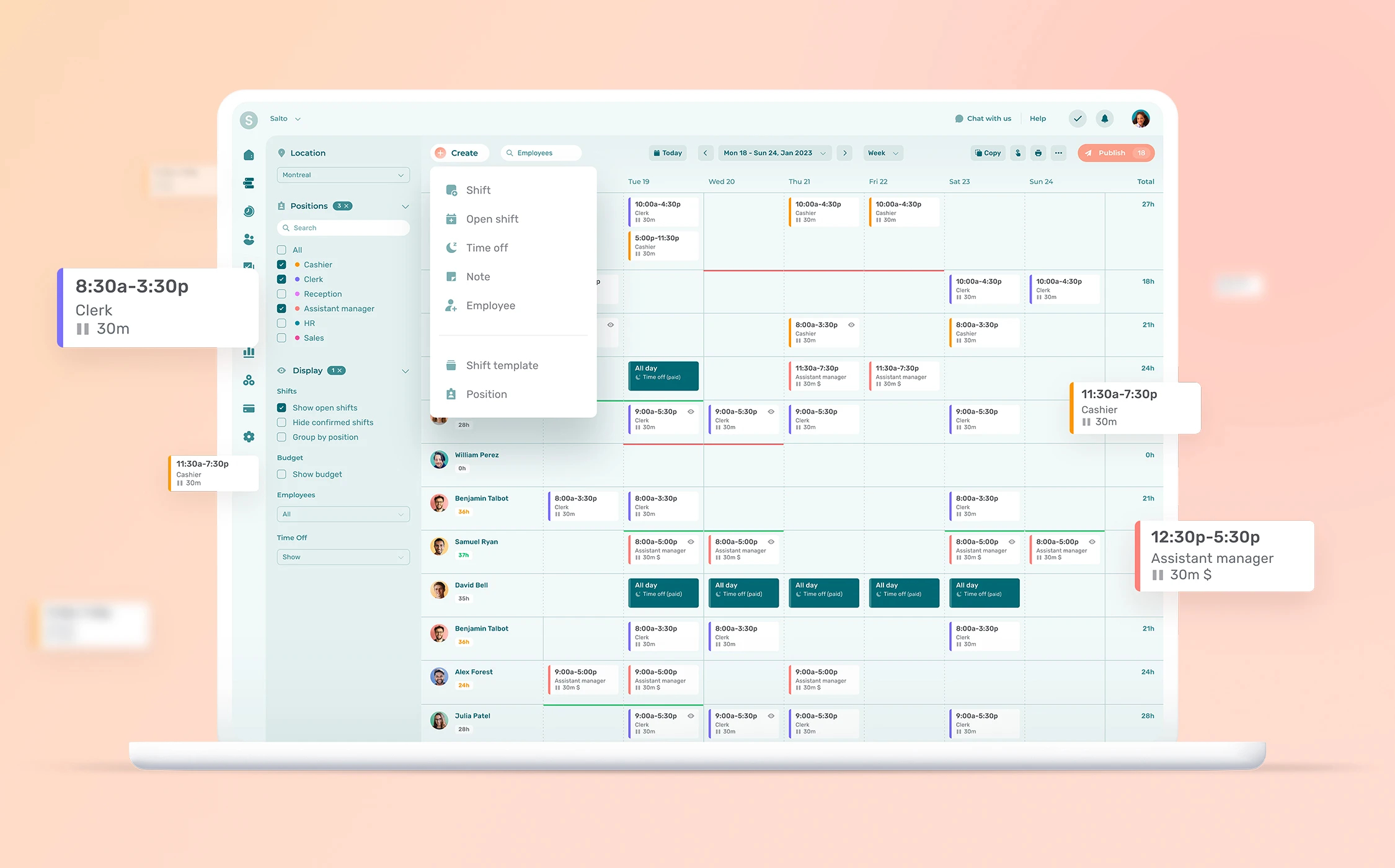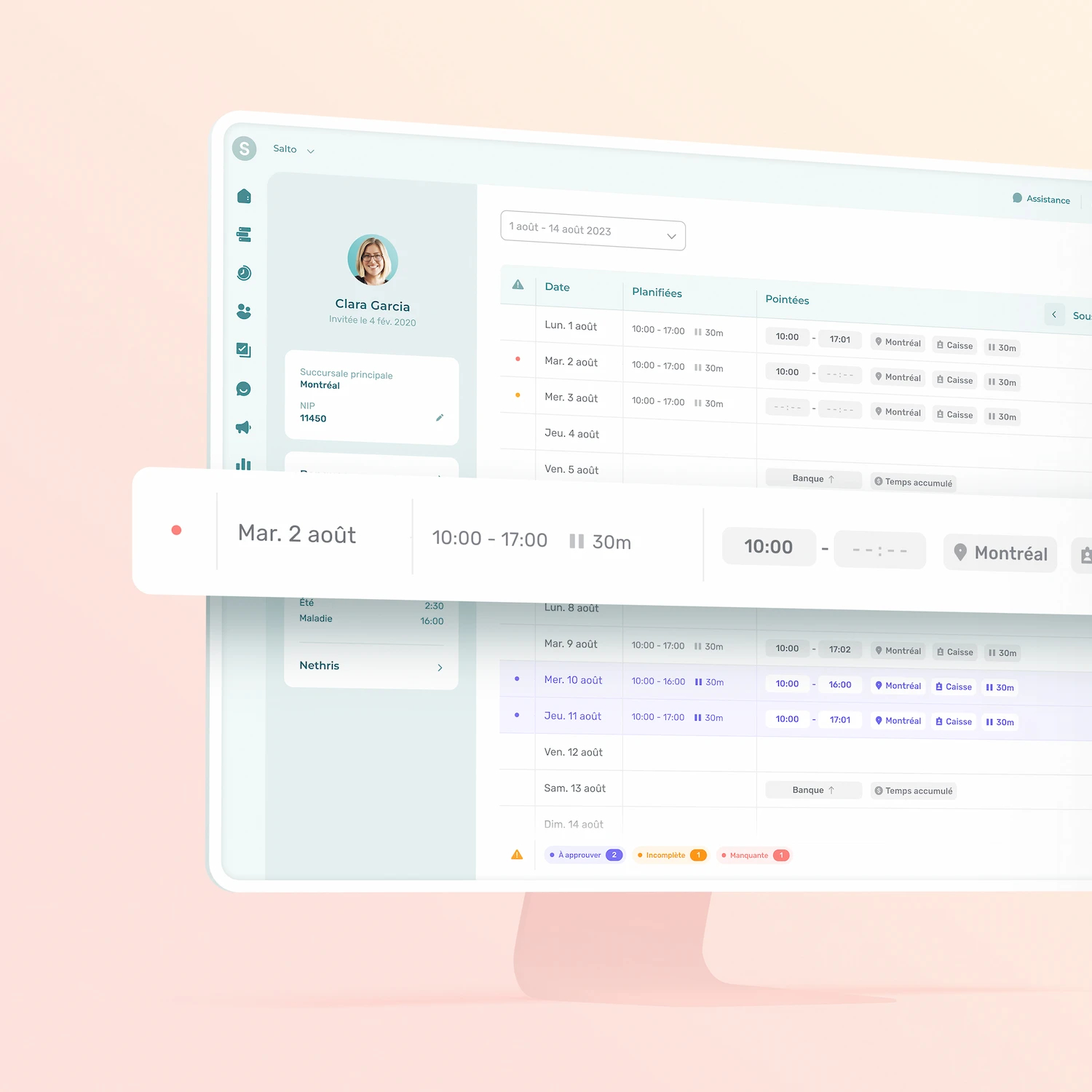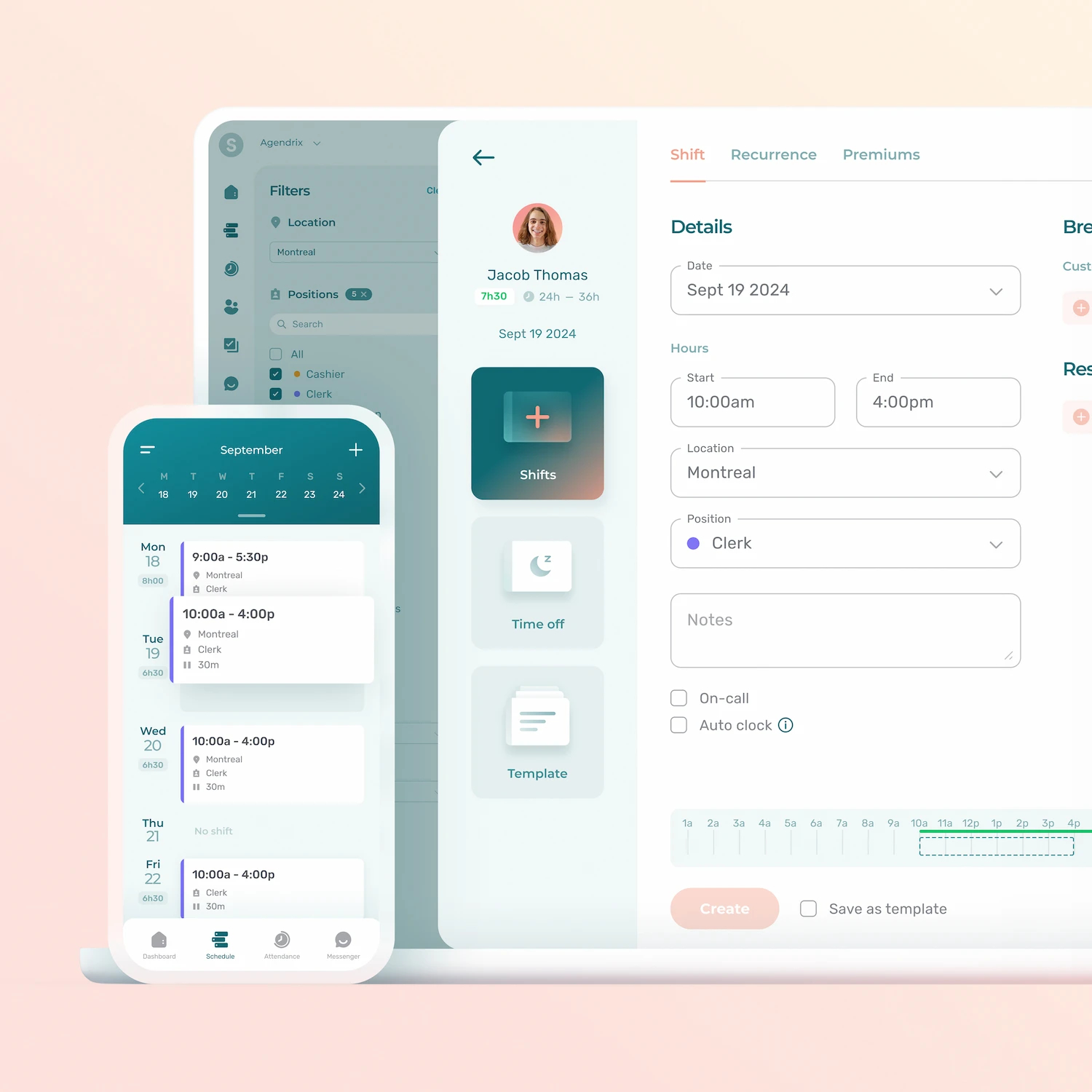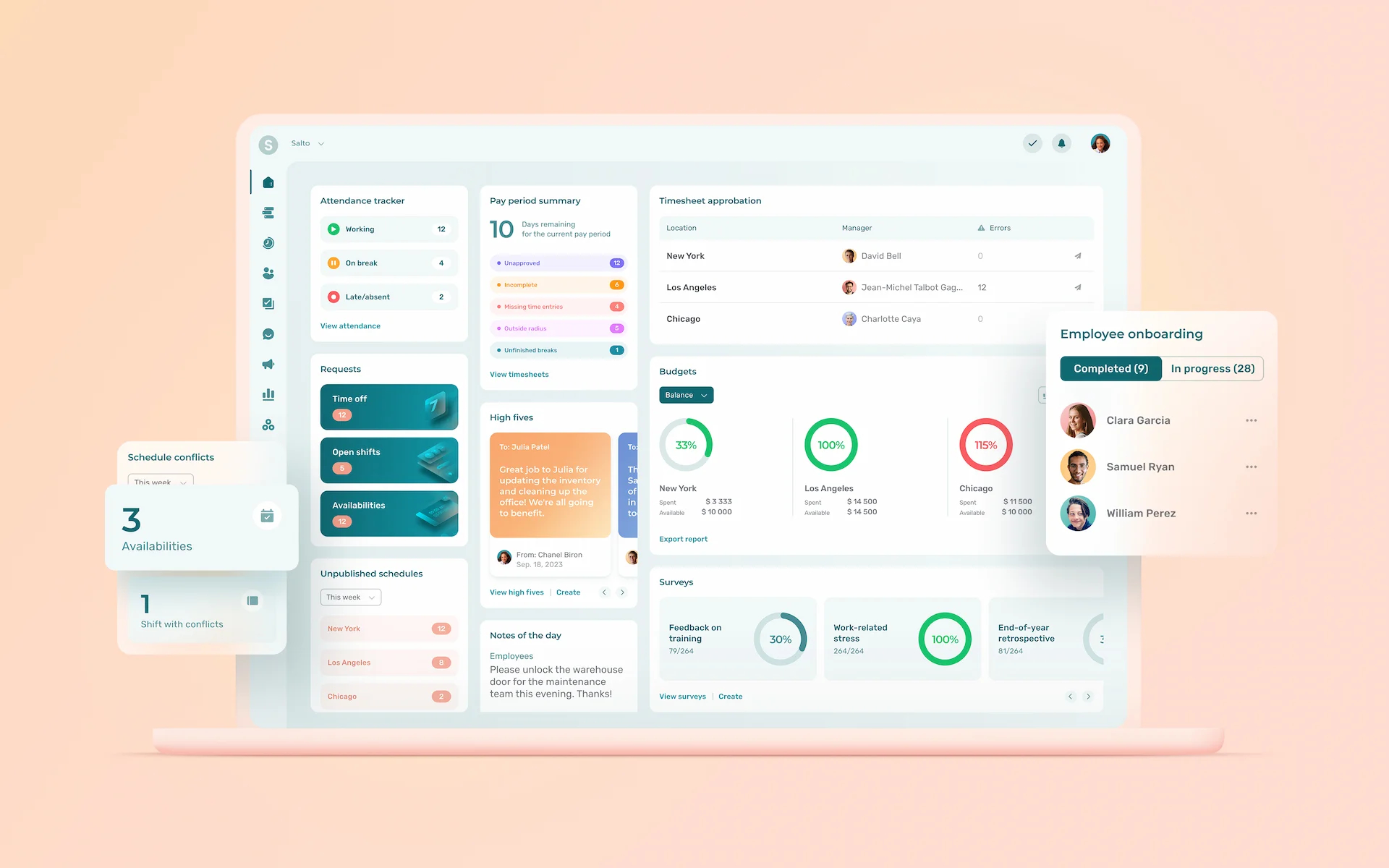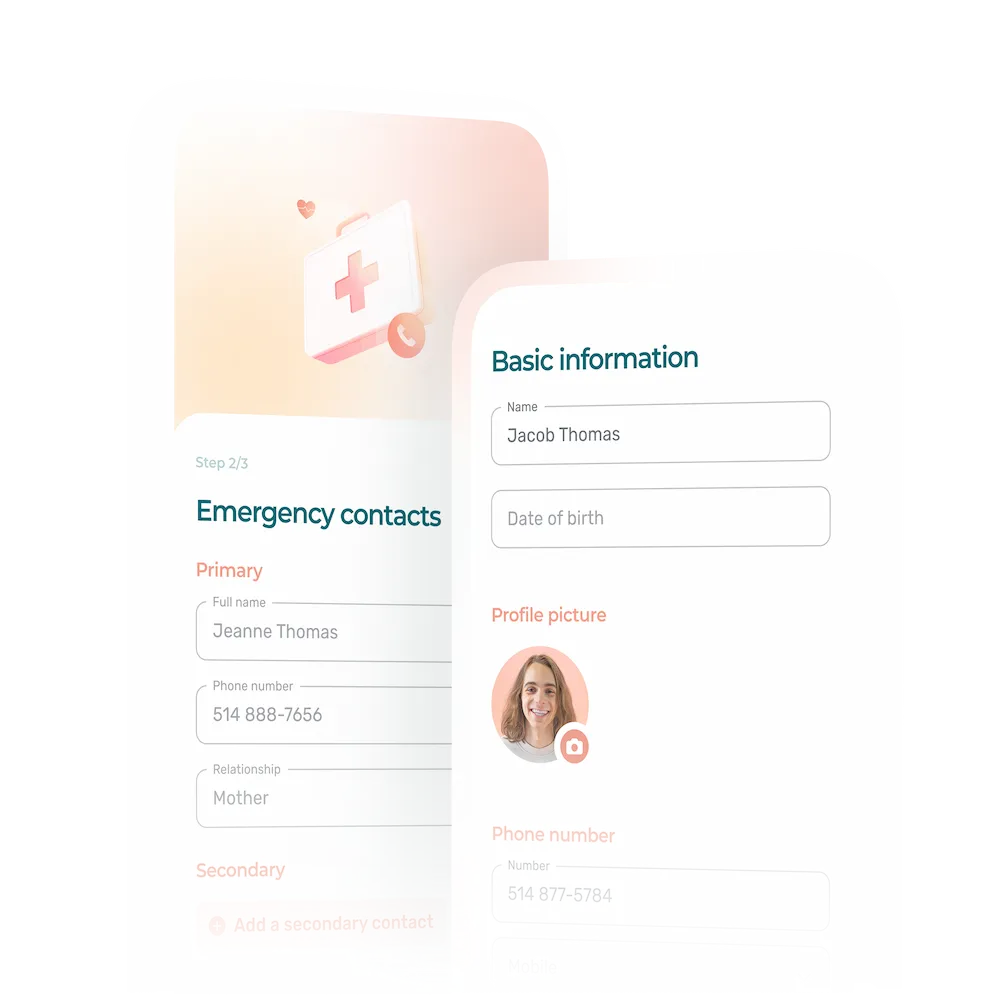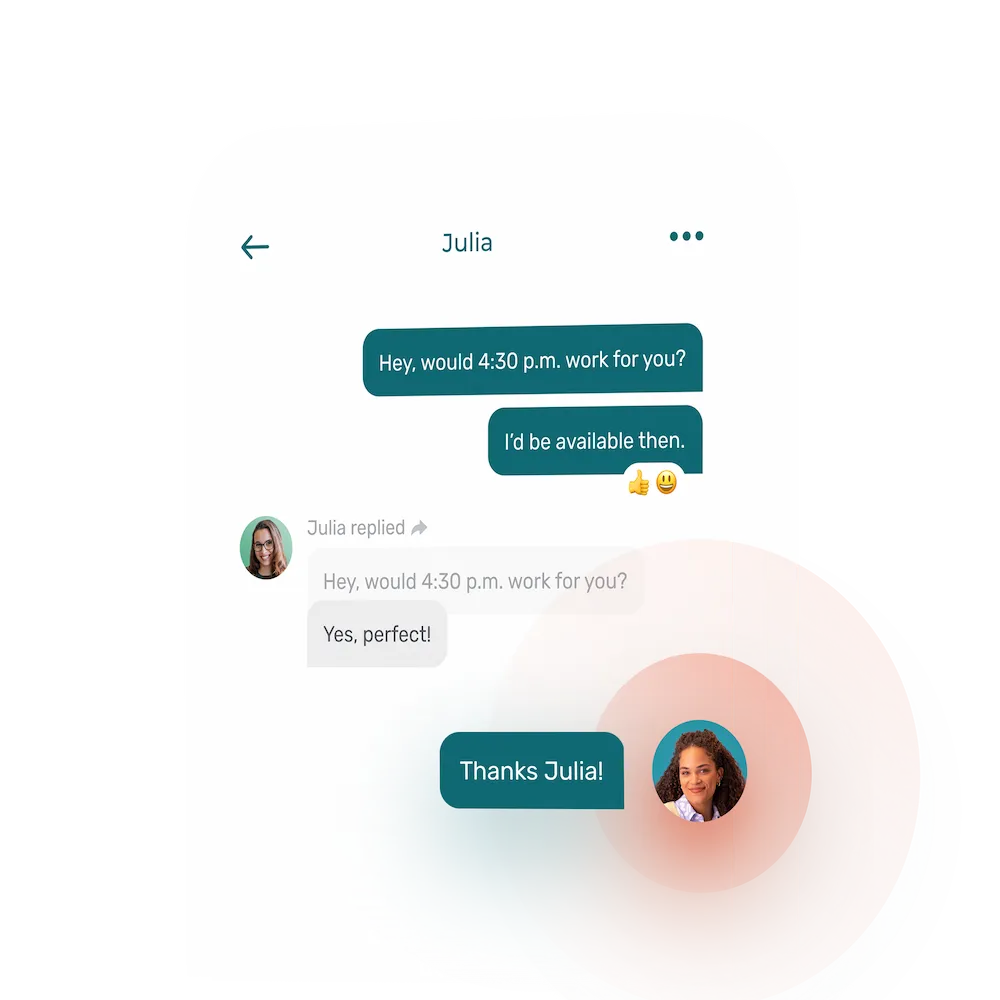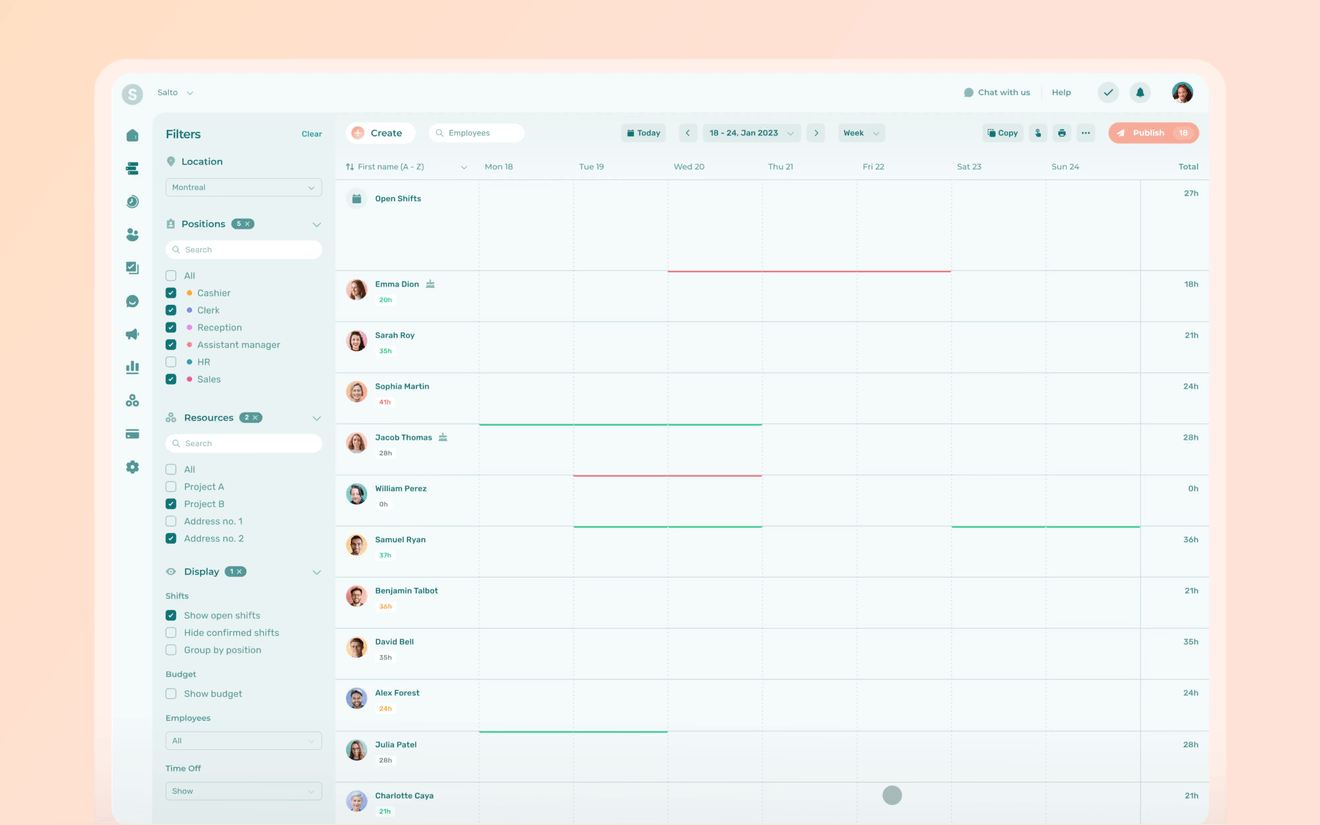Any business that relies on employees to operate can benefit from a work schedule maker, especially those with variable demand, a large number of part-time workers, or complex compliance requirements.
Here’s how to choose the right free schedule maker for your business, along with step-by-step instructions for creating work schedules online in no time.
Key Takeaways
- Using a shift schedule maker can optimize staffing, improve employee satisfaction, and boost business performance.
- Not all schedule makers are equal. The best schedule maker is the one that best meets your business needs. Do you need a simple weekly schedule template, a free online schedule maker or a feature-rich monthly schedule maker? Analyze your business needs carefully and base your decision accordingly.
- A good work schedule maker will also centralize all employee data and integrate with your other day-to-day systems like payroll and accounting software.
- There are many free online schedule makers, but if they don’t improve your efficiency and scheduling practices, they won’t add value to your business.
- As with all business purchases, make value your key determining factor, not upfront cost when comparing online schedule makers.
- Choose wisely and your employees, managers and business will all profit.
A schedule maker is a software application used to create, manage, and distribute work schedules for employees or tasks within an organization. It streamlines the entire process of assigning shifts, managing time-off requests, tracking hours worked, and ensuring that the workforce is utilized efficiently. Schedule makers often come with features like drag-and-drop interfaces, free schedule templates, and integrations with other business systems such as payroll and time tracking tools.
Why Planning With a Schedule Maker Is Essential
Using an employee schedule maker helps businesses optimize scheduling, improve employee satisfaction, and boost overall business performance—all crucial for maintaining competitive advantage and operational success.
A good employee scheduling tool goes well beyond basic scheduling tasks. It can also help you improve employee communication, monitor and lower labor costs, improve compliance with labor laws, track work hours, and streamline the payroll process.
The trick is finding the best employee schedule maker for your business. A free online schedule maker offering basic schedule templates may not be enough. Choose wisely, and your employees, managers, and business will all profit.
Businesses That Need a Shift Schedule Maker
Any business with variable demand, many part-time workers, or complex compliance requirements should use a work schedule maker.
This includes:
- Retail
- Pharmacy
- Retirement home
- Construction
- Restaurants & bars
- Hotels & hospitality
- Events & recreation
- Seasonal & tourism
- Cleaning services
- Catering
- Healthcare
- Offices & call centers
- Home care
- Security services
- Cities & municipalities
What to Look for in an Online Schedule Maker
Not all online schedule makers are equal. Some come crammed with features that can significantly improve operational efficiency. Below are some common must-have features to look for in a weekly or monthly schedule maker.
Variety of Schedule Templates
Different types of businesses often need to use different types of weekly schedules: rotating, Dupont, part-time, split-shift, compressed workweek, etc.
But often, there’s more than one type of schedule that could potentially make a good fit. You may need to test-run multiple schedules for a while to see which one best meets the needs of your business and employees.
What’s the best work schedule for your business?
See our Comprehensive Guide to Different Work Schedule Types—the most common types of weekly schedules, pros & cons, types of businesses they are best suited for, and how they work.
A schedule maker that offers a variety of schedule templates will let you do just that. Some even let you create your own custom schedules.
This flexibility can also come in handy:
- If your business is subject to seasonal changes, special events, or varying demand. You can simply select the most appropriate template for the situation.
- As your business grows and evolves. There’s a good chance your scheduling needs will too.
Looking to create custom schedules?
See the 7 Types of Shift Work: Benefits, Challenges & How to Choose the Best Fit for Your Business.
User Interface
A user-friendly interface is key to a good schedule maker. It’s vital that staff at all levels can navigate the software easily; otherwise, they won’t use it properly—or at all. The user interface should be clean, intuitive, and simple.
What first charmed us about Agendrix is its ease of use: it’s a very intuitive app. Even our employees who are reluctant to use technology quickly adopted it. It pleases all our employees, from 15 to 74 years old!
– Lara May-Viger, Manager and Accountant at RONA
Mobile App Accessibility
Chances are all of your employees carry their phones 24/7. Your weekly schedule maker should come with a mobile app so that employees can stay up-to-date on their work schedule on the go.
Employee Seniority & Positions
In some industries or unions, scheduling or open shifts based on seniority is a requirement. This feature will ensure your business is complying with such regulations.
Even if your business isn’t subject to seniority requirements, incorporating seniority and positions into scheduling can be a smart move:
- It ensures shifts are staffed with an appropriate mix of experienced and junior employees.
- Optimizing the skill distribution for each shift will ensure a good level of customer service while also enhancing on-the-job training.
- Recognizing seniority in scheduling decisions can contribute to a sense of fairness and respect within the workforce, potentially improving morale and reducing employee turnover.
Employee Availability & Paid Time off Requests
Accommodating employee preferences where possible leads to higher job satisfaction and work-life balance, which can translate to improved performance and lower absenteeism.
A good schedule maker will account for employee availability and PTO requests. This will:
- Ensure employees are scheduled only when they are available.
- Avoid unnecessary overtime and ensure labor resources are used efficiently.
- Minimize scheduling conflicts and reduce the amount of time managers need to spend on resolving these issues.
See 10 Effective Ways to Manage Scheduling Conflicts & Boost Employee Morale.
Instant Communication + Notifications
Keeping lines of communication open and accessible enhances employee engagement by making them feel connected and informed. This covers everything from company policies to internal procedures to work schedules.
Choosing a schedule maker with instant communication and notification features allows you to:
- Share with your team real-time updates on schedule changes, reducing the likelihood of miscommunication and the inevitable late or no-shows that can ensue.
- Respond more quickly to unforeseen changes, such as calling in replacements for last minute absences, which helps maintain operational continuity.
- Leave important day-of notes for the team. For instance, a restaurant manager can leave a note for employees coming onto a shift that there has been a last-minute change to the menu, or that a large group is expected at 8 pm.
Effective communication is especially important for keeping night shift workers informed and engaged, as they typically get less face-to-face time with managers and administrative staff.
Shift Swapping
Shift swapping gives employees some flexibility and control over their schedules. This feature may even allow them to swap shifts with colleagues without direct managerial intervention, as long as the swaps meet predefined criteria.
Choosing an online schedule maker with a shift-swapping feature will:
- Reduce the administrative burden on managers by automating the process of shift swaps, including approvals based on set rules and requirements.
- Ensure shifts are covered even when the original employee assigned to the shift cannot make it, without compromising service quality or productivity.
- Minimize the risk of no-shows, leading to better time & attendance.
Analytics and Reporting
Advanced analytics and reporting capabilities within a schedule builder can provide insights into various aspects of workforce management, such as labor costs, scheduling trends, employee utilization rates, and overtime analysis. This can significantly enhance a business’s ability to manage its workforce efficiently, adapt to changes quickly, and maintain high levels of employee satisfaction and productivity.
Some schedule makers make it easy to create custom reports tailored to your specific business needs.
Having access to real-time analytics and reporting helps managers:
- Make informed decisions based on data, such as identifying overstaffing or understaffing trends, optimizing shift patterns, and controlling labor costs.
- Identify high-performing employees and those who may need additional support or training, allowing for targeted personnel development.
- Monitor compliance with labor laws and internal policies by providing detailed records of work hours, breaks, and overtime.
8 Benefits of Using a Schedule Maker
Choosing the right schedule builder can significantly improve your business’s operational efficiency in several ways.
1. More Efficient Resource Allocation
A schedule maker helps you allocate human resources efficiently, ensuring that the right number of employees with the necessary skills are available when needed. This makes it easier to maintain productivity levels and meet customer demands without overstaffing or understaffing, which can lead to increased labor costs or poor service quality.
2. Easier Compliance With Labor Laws
Many countries and regions have strict labor laws on working hours, overtime, breaks, and minimum rest periods between shifts. A schedule builder can alert you to potential violations before they occur. That way, you can avoid legal penalties and protect your business’s reputation.
3. Fewer Scheduling Conflicts
Manual scheduling is prone to human error, which can lead to double-booking, scheduling employees when they are unavailable, or not accounting for time-off requests. A schedule maker automates much of this process, which will reduce conflicts and the administrative burden of resolving them.
4. Better Work-Life Balance for Employees
A schedule maker can take into account employee preferences for certain shifts or days off. It makes it easier for employees to swap shifts or request changes, which can significantly improve job satisfaction and work-life balance. In turn, this can lead to reduced turnover rates and a more motivated workforce.
Ensuring a good life balance for on-call employees can be especially challenging. See 7 Tips for Employee-Centric Approach to On-Call Scheduling + Benefits & Template.
5. More Data-Driven Decision-Making
Some schedule makers, like Agendrix, come with analytics and reporting tools that provide insights into labor costs, peak operation times, and employee performance. This data can help you make more informed decisions about staffing levels, budgeting for labor costs, and improving operational efficiencies.
6. Greater Adaptability to Changing Business Needs
To stay profitable, many businesses must be able to adapt quickly to changing conditions like seasonal fluctuations, promotional events, or unexpected demand surges. With a schedule maker, you can rapidly adjust your workforce schedule to keep your business agile and responsive.
7. Better Employee Communication
Modern schedule makers, like Agendrix, include communication features that allow for real-time updates and notifications about schedule changes, the day’s tasks, and more. Now you can reduce misunderstandings and ensure that all employees are informed about their shifts promptly. And managers can avoid having to use Facebook Messenger to chat with employees.
8. Centralized Data and System Integration
An advanced schedule maker will also centralize all employee data—from employee records and onboarding information to anniversary notifications and recognition messages. It will also integrate with your other day-to-day systems like payroll and accounting software.
How to Make a Weekly Schedule in 13 Steps
Here’s a step-by-step guide to creating a weekly schedule using a generic free schedule maker:
Step 1: Select Your Schedule Maker Tool
Choose a schedule maker tool that suits your business needs. Most free schedule makers come in the form of a weekly schedule maker or a monthly schedule maker. There are also specialized employee scheduler maker software options, such as Agendrix, that offer features tailored for employee scheduling, including shift swaps, time-off requests, and mobile access.
Looking for a free schedule maker?
Use our free weekly Excel employee scheduling template.
Step 2: Gather Employee Information
Collect necessary information from your employees, including their availability, preferred shifts, time-off requests, and any other constraints or preferences. This step is crucial for creating a schedule that accommodates employee needs as much as possible.
Get our Free Employee Availability Form Template
Step 3: Understand Business Requirements
Assess your business needs for the month, including expected busy periods, special events, or deadlines that might require additional staffing. Consider the roles and skills required for each shift to ensure you have the right coverage.
Step 4: Access the Scheduling Interface
Log in to your chosen schedule maker and navigate to the scheduling interface. This is typically a calendar view where you can add, edit, and view shifts.
Step 5: Create Shifts
Start creating shifts by choosing the shift type (traditional or training) and specifying the date, time, and position or role required for each shift. Use the information gathered in steps 2 and 3 to distribute shifts in a way that matches employee availability with business needs.
If your schedule maker has an import feature, you could even import everything directly in the app.
Step 6: Assign Employees to Shifts
Assign employees to each shift, taking into account their availability, preferences, and the needs of the business. Ensure that all shifts are covered by appropriately skilled staff.
Step 7: Handle Time-off Requests
Incorporate approved time-off requests into the schedule, ensuring that these employees are not scheduled for shifts during their time off.
Get our Free Vacation Request Form Template
Step 8: Optimize the Schedule
Review the draft schedule for any gaps, overlaps, or imbalances in shift distribution. Make adjustments as necessary to ensure that the workload is evenly distributed and that the new schedule is as fair as possible to all employees.
Step 9: Comply With Labor Laws
Make sure your schedule complies with all relevant labor laws, including those related to maximum working hours, minimum rest periods, and overtime regulations.
Learn more about Work Schedule & Your Obligations as an Employer.
Step 10: Share the Schedule With Employees
Once the schedule is finalized, publish it and share it with your employees. Most schedule maker tools allow you to notify employees of the finished schedule via email, SMS, or mobile app.
Step 11: Allow for Shift Swaps and Adjustments
Enable features that allow employees to request shift swaps or changes through the schedule maker tool. This flexibility can help address unexpected personal conflicts and improve employee satisfaction.
Some scheduling tools, like Agendrix, give you the option to allow employees to swap shifts autonomously, provided they meet certain predefined criteria, or only after the manager’s approval.
Step 12: Monitor and Adjust as Needed
Throughout the month, monitor the schedule. Be prepared to make adjustments for unexpected absences, changes in business needs, or employee requests. Have the schedule maker automatically notify employees of any changes made to the schedule in real time.
Step 13: Gather Feedback
Continuously seek feedback from your employees about the schedule and other work-related topics. Use this feedback to make improvements in future scheduling. Having an employee work schedule that balances the needs of your business with the preferences and availability of your team will improve employee satisfaction, reduce turnover, and boost operational efficiency.
How to Create a Monthly Schedule
For some businesses, it can be more practical to create a monthly work schedule for employees—such as those with predictable workloads.
If your schedule doesn’t change much from week to week, the steps are the same as for creating a weekly schedule. You’ll just have to make adjustments to account for time off, holidays, etc. as necessary.
Agendrix scheduling software has a handy weekly schedule templates feature that makes creating monthly work schedules really quick and easy.
- Simply save a typical week as a template and reuse it as often as you like.
- Reassign shifts to match your needs and to the right employees.
- If your staffing needs change at different times throughout the year (such as the busy pre-Christmas period in retail), simply build and save different templates for different periods. Give clear names to your templates and then import them at the appropriate time.
See what else you can do with the weekly schedule templates feature in Agendrix!
Sharing Your Schedule, a Critical Step to Success
Having the best schedule creator in the world is worthless if employees don’t see their shifts on time. Rather than pinning it on the wall or emailing it to everyone, you can have your schedule maker automatically send the latest updates to all concerned employees. They’ll automatically receive a notification if changes are made to the original schedule.
Agendrix: A Schedule Maker for Peace of Mind
Agendrix is the best schedule maker online for businesses that want a flexible and scalable feature-rich scheduling software that can integrate seamlessly with their existing payroll, timesheet, and other HR systems.
With Agendrix, you also get professional customer support and reliability, including quick access to customer service, training resources, and our extensive knowledge base.
How much does it cost to make a schedule with Agendrix schedule maker?
The Agendrix schedule maker comes with three different plans to meet the needs of most small, medium, and enterprise-size businesses. Each plan also comes with a free trial so that you can try making a schedule with Agendrix without commitment.
Conclusion
Free scheduling tools might seem cost-effective initially, but they often lack the advanced features, scalability, and support that businesses need to optimize their operations and grow. By focusing on the value provided by a comprehensive, purpose-built employee scheduling tool, businesses can improve efficiency, save money in the long run, and build a more satisfied and productive workforce.
How to Create a Schedule Online for Free?
- There are many free online schedule tools; a quick Google search will turn up many.
- If you want to see the added value that comes from using professional employee scheduling software without any commitment, Agendrix offers a free trial that lets you test-run its feature-rich scheduling software at no cost.
- Or you can try one of our free work schedule templates.
What Program Use to Create a Schedule?
Many programs can create a weekly or monthly schedule, like Excel, Google Calendar, or Asana, but these are not designed specifically to optimize employee scheduling practices and labor costs.
This is best done with fit-for-purpose scheduling software designed for businesses, like Agendrix, which includes features for shift scheduling, time and attendance tracking, payroll integration, employee management and communication.
How to Create a Free Employee Work Schedule?
There are several ways to create an employee work schedule for free:
- Pen and paper
- Excel or Google sheets (see how to create a work schedule in Excel)
- Word document (here’s a free Word employee scheduling template)
- Free online employee scheduling software
- Free trial of a professional employee scheduling software that comes with a mobile app for employees
How to Create a Shift Schedule?
Here are the key steps in creating a monthly or weekly shift schedule:
- Step 1: Choose a schedule maker tool that best meets your business needs
- Step 2: Gather the necessary information from your employees (availability, time-off requests, preferences, etc.)
- Step 3: Analyze your staffing needs for the time frame being scheduled
- Step 4: Access the software’s scheduling interface
- Step 5: Create shifts and assign employees to shift
- Step 6: Share the schedule with employees
- Step 7: Review and adjust the schedule as needed





